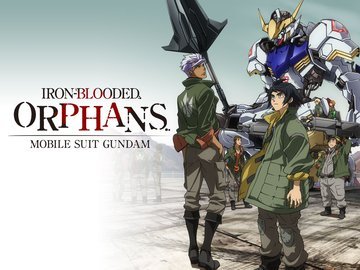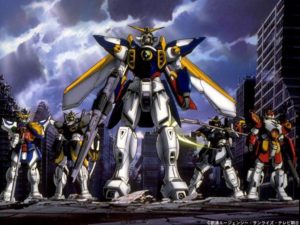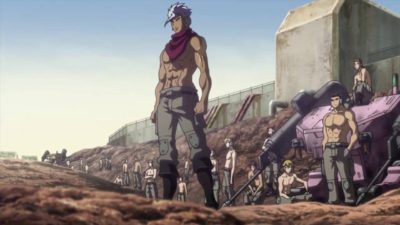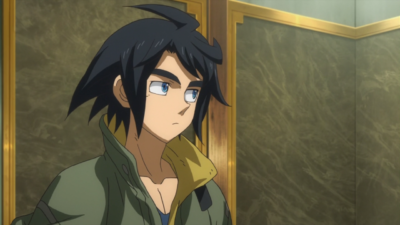Sunrise’s Gundam franchise, despite being on American TVs multiple times throughout the years, has never broken into the popular culture the way other properties such as Dragon Ball have. It is one of the biggest anime/manga/light novel properties in the world and arguably the most important name in the mecha genre, but here in the States it is often seen like a second tier anime. Sure, casual anime fans likely know what it is and they might have even have bought one of the model kits, but that’s often because they think the model looks cool as opposed to any major attachment to the story or characters the kit is from.
Like a great many people, I was first introduced to Gundam as part Cartoon Network’s Toonami block, which has shown several Gundam series (including the one I’m here to talk about today) over the years. In my case it was Gundam Wing, and I’ve since watched most of the serious Gundam material (stuff like Build Fighters can go suck an egg) So I know this franchise well, including its shortcomings.
The issues people have with the Gundam franchise are three-fold. Firstly, is that most often Gundam has complex and convoluted plots and they don’t always explain everything in the main story. Keeping up with who everyone is and why they are doing what they are at any given moment requires a bit of effort on the viewers part. Usually there is supplemental material you can read to fill things out more, but a lot of people have issues with the idea of getting into a series involving homework. The second issue is that even with the convoluted plots each version of Gundam tells the same story. Gundam recycles story elements and themes regularly, to the point where it feels like the creators a checklist of things they have to add to the story whether they serve the series well or not. It isn’t an entirely unfair argument to say if a person has seen one Gundam series, they have seen every Gundam series. Lastly, the Gundam franchise has a bad habit of crawling up its own ass at points and getting more than a little pretentious.
What?! I may be a fan, but that doesn’t mean I’m going to sugarcoat things.
I wanted to get that all out of the way so that you can believe that I’m not some blind fanboy when I tell you that Mobile Suit Gundam: Iron-Blooded Orphans is one of the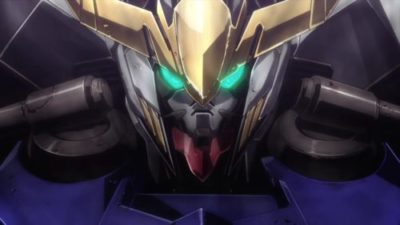 best shows out there in anime today. The strength of Iron Blooded Orphans lies its ability to mostly avoid the first and third pitfalls while putting a fresh spin on the classic Gundam formula. Make no mistake, Iron Blooded Orphans is firmly a Gundam series, but the creators wisely decided that even though they have a template they are expected to follow that didn’t mean they got to slack off in the creativity department.
best shows out there in anime today. The strength of Iron Blooded Orphans lies its ability to mostly avoid the first and third pitfalls while putting a fresh spin on the classic Gundam formula. Make no mistake, Iron Blooded Orphans is firmly a Gundam series, but the creators wisely decided that even though they have a template they are expected to follow that didn’t mean they got to slack off in the creativity department.
The show feels very familiar yet also feels like very much its own thing. For example, most iterations of the franchise focus on the horror of war and young people getting sucked up into these vast and complicated conflicts, Iron Blooded Orphans stays true to this theme, but instead of having the protagonists be innocents dragged into war or a secret underground group fighting for freedom our protagonists are the child soldiers of the PMC (Private Military Company) Tekkadan. These aren’t kids who had some other future, they have nothing else and nowhere to go and when Orga Itsuka takes his division rogue to avoid being used as cannon fodder he doubly commits everyone under him to the path of the warrior.
Tekkadan is all these kids got and it is either keep pressing forward or go find a nice hole to go die because there are no other options. These are mostly uneducated children who would be homeless or sold into slavery otherwise. The journey then is how do these kids find their own way and carve out a decent life for themselves as they try to solidify their power base in an increasingly complex and corrupt system. Its an easy plot to get behind and it only gets better from there.
Despite all my praise, the show isn’t perfect. The second season seems to have stalled a little bit. The first season was much more straightforward, focusing on the the main objective of getting Mars rights activist, Kudelia Aina Bernstein from Mars to where she needed to go on Earth in one piece with bits of world building sprinkled in to help provide context and backstory. The second has a lot of moving parts to it as it has been fleshing out the world and all its players and has had to spend considerable time moving all the pieces into place for their inevitable confrontations. It is all still good, and the mid-season finale was the perfect gut punch to set up the back half of the season, but it could have been a bit more streamlined and cleaner, leaving more time for the big drama and battles we know are coming.
Some people have also complained that the main pilot and Orga’s best friend, Mikazuki Augus is lacking depth and is a bit boring. I can see why they feel that way, but I respectfully disagree. Mika is a very reserved and internal character and just because he isn’t very expressive doesn’t mean there isn’t anything going on behind those eyes. Part of the show is showing that while Mika is a bad-ass, he is also severely emotionally and socially stunted. Instead of screaming and crying all the time like most Gundam main characters, Mika’s journey is much quieter and more subtle and I find it a welcome change.
I could easily dissect and analyze all the cool things about this show all day, but that isn’t what I want to do here. It is my hope that I have hyped up the show enough for people to go check it out and make up their own minds about it. Bottom line here, Mobile Suit Gundam: Iron-Blooded Orphans is a great entry point for newbies wanting to give Gundam a shot as well as a gateway back for older fans who may have been disappointed by previous series and fell off because of it. The story is engaging, the characters understandable, it is morally and emotionally challenging at points, and it has all the giant robot fighting action you could want. This is one of Gundam’s alternate timeline series which means it is a stand-alone work so you don’t have to worry about having not watched other Gundam shows to understand what is going on and the show gives just enough information where you don’t need to run down the supplemental material. It is out there for those who want it, but it isn’t needed. Iron-Blooded Orphans is super easy to find and see if it is a good fit for you. You can the series on Crunchroll, Funimation, Hulu, and several other portals. Toonami ran a dubbed version of the first season, and will likely do the same for the second once it has finished up. I’ve even embedded the first episode below for your viewing convenience so that you can dive right this second. Hop to it folks, and enjoy the ride.
https://www.hulu.com/watch/852258#i0,p0,d0

